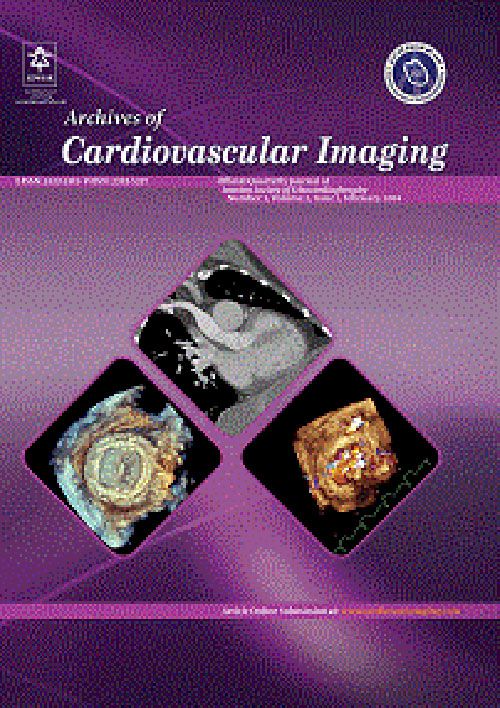فهرست مطالب

Archives Of Cardiovascular Imaging
Volume:5 Issue: 1, Feb 2017
- تاریخ انتشار: 1396/10/25
- تعداد عناوین: 4
-
Page 1BackgroundMyocardial ischemia may be caused by microvascular disease. The ratio of the maximal possible coronary blood flow to the resting coronary blood flow is termed the coronary flow reserve (CFR), which may be assessed noninvasively via dipyridamole stress echocardiography (DSE). Ranolazine is an anti-ischemic agent whose effect on the coronary flow is poorly known.ObjectivesWe sought to assess temporal variations in the CFR after and before ranolazine administration in a real clinical practice setting among patients with angina and non-obstructive epicardial coronary artery disease.MethodsSeven patients were enrolled, and their demographic, electrocardiographic, and laboratory data were recorded. The CFR was calculated in the anterior descending coronary artery. The definition of abnormal microcirculation was a cutoff value under 2.5. Treatment lasted for 3 months, after which time the same response variables as before were recorded. A general linear model was used to assess whether there was a difference between the pre- and post-administration of ranolazine.ResultsSeven patients were evaluated. At follow-up, there was no discontinuation or side effect. The CFR significantly increased with time (F1,6 = 6.909; P = 0.039). Initially, the mean (± 1 SD) value was 1.85 (± 0.34), which rose up to 2.21 (± 0.31) after the 3-month treatment period.ConclusionsRanolazine might have beneficial effects on the CFR as assessed by DSE in patients with angina and non-obstructive epicardial coronary artery disease.Keywords: Coronary Flow Reserve, Ranolazine, Coronary Flow Reserve, Ranolazin, Ranolazin, Echocardiogram
-
Page 2A variant of takotsubo cardiomyopathy is the inverted takotsubo type, where the wall motion abnormalities affect the basal and mid segments but spare the apex. We describe a case of this variant induced by cocaine and methamphetamine consumption. There are reported cases of transient apical ballooning associated with drug abuse, but none of them presented with the inverted variant and low cardiac output treated with levosimendan.Keywords: Inverted Takotsubo Cardiomyopathy, Drug Abuse, Levosimendan
-
Page 3Postpartum Takotsubo cardiomyopathy is mainly induced by drugs that enhance sympathetic nervous activity. We report a novel case of postpartum inverted Takotsubo cardiomyopathy triggered by intravenous atropine administration resulting in acute pulmonary edema. Cardiac troponin I and beta-type natriuretic peptide were elevated. Transthoracic color Doppler echocardiography demonstrated a nondilated left ventricle with mid-basal akinesis, a hyperdynamic apex, and moderate-to-severe mitral regurgitation likely linked to papillary muscle dysfunction. Coronary computed tomography angiography revealed normal coronary arteries. Atropine inhibits the parasympathetic nervous system, alters the autonomic system balance, and, thus, leads to increased sympathetic nervous activity, which seems to have been the cause of Takotsubo cardiomyopathy in this patient. Atropine should be listed among the drugs triggering Takotsubo cardiomyopathy.Keywords: Takotsubo Cardiomyopathy, Cardiomyopathies, Echocardiography Doppler Color, Atropine
-
Page 4IntroductionLeft ventricular (LV) free wall rupture is a rare but catastrophic complication of acute ST-elevation myocardial infarction (STEMI) and is still present in the era of aggressive reperfusion therapy.Case PresentationAn 81-year-old man with a history of hypertension and dyslipidemia was admitted to our hospital with anterior STEMI. While being prepared for coronary angiography, the patient underwent a focused 2D and Doppler echocardiographic study, which revealed akinesis in the apical segments of the LV and hyperkinesis in the adjacent segments, with a mild impairment in the LV ejection fraction (46%). This pattern of regional wall motion abnormalities was confirmed by speckle-tracking echocardiography. Fifteen minutes after hospital admission, he suffered sudden cardiac arrest, for which resuscitation was commenced immediately. Repeat echocardiography revealed massive pericardial effusion, resulting in cardiac tamponade. Pericardiocentesis was performed, but the ensuing resuscitation efforts were unsuccessful.ConclusionsWe present a unique recording and quantitative analysis of the LV wall motion abnormalities immediately preceding free wall rupture in nonrevascularized anterior STEMI. We hypothesize that significant differences in the regional function, ranging from an akinetic apex to hypercontractile segments adjacent to the necrotic zone, can represent a marker of threatened cardiac rupture.Keywords: Strain Echocardiography, Cardiac Rupture, Acute Myocardial Infarction


